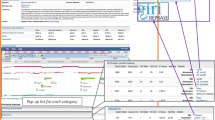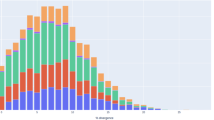Abstract
Transposable elements (TEs) are important contributors to genome structure and evolution. With the growth of sequencing technologies, various computational pipelines and software programs have been developed to facilitate TE identification and annotation. These computational tools can be categorized into three types based on their underlying approach: homology-based, structural-based, and de novo methods. Each of these tools has advantages and disadvantages. In this chapter, we introduce EDTA (Extensive de novo TE Annotator), a new comprehensive pipeline composed of high-quality tools to identify and annotate all types of TEs. The development of EDTA is based on the benchmarking results of a collection of TE annotation methods. The selected programs are evaluated by their ability to identify true TEs as well as to exclude false candidates. Here, we present an overview of the EDTA pipeline and a detailed manual for its use. The source code of EDTA is available at https://github.com/oushujun/EDTA.
Access this chapter
Tax calculation will be finalised at checkout
Purchases are for personal use only
Similar content being viewed by others
References
McClintock B (1948) Mutable loci in maize. Carnegie Inst Wash Year Book 47:155–169
McClintock B (1950) The origin and behavior of mutable loci in maize. Proc Natl Acad Sci 36:344–355
Schnable PS, Ware D, Fulton RS, Stein JC, Wei F, Pasternak S, Liang C, Zhang J, Fulton L, Graves TA (2009) The B73 maize genome: complexity, diversity, and dynamics. Science 326:1112–1115
Feschotte C, Jiang N, Wessler SR (2002) Plant transposable elements: where genetics meets genomics. Nat Rev Genet 3:329–341
Wicker T, Sabot F, Hua-Van A, Bennetzen JL, Capy P, Chalhoub B, Flavell A, Leroy P, Morgante M, Panaud O et al (2007) A unified classification system for eukaryotic transposable elements. Nat Rev Genet 8:973–982
Goerner-Potvin P, Bourque G (2018) Computational tools to unmask transposable elements. Nat Rev Genet 19:688–704
Lerat E (2010) Identifying repeats and transposable elements in sequenced genomes: how to find your way through the dense forest of programs. Heredity (Edinb) 104:520–533
Ou S, Su W, Liao Y, Chougule K, Agda JRA, Hellinga AJ, Lugo CSB, Elliott TA, Ware D, Peterson T, Jiang N, Hirsch CN, Hufford MB (2019) Benchmarking transposable element annotation methods for creation of a streamlined, comprehensive pipeline. Genome Biol 20 (1):275. https://doi.org/10.1186/s13059-019-1905-y
Ellinghaus D, Kurtz S, Willhoeft U (2008) LTRharvest, an efficient and flexible software for de novo detection of LTR retrotransposons. BMC Bioinformatics 9:18
Ou S, Jiang N (2019) LTR_FINDER_parallel: parallelization of LTR_FINDER enabling rapid identification of long terminal repeat retrotransposons. bioRxiv. https://doi.org/10.1101/722736
Ou S, Jiang N (2018) LTR_retriever: a highly accurate and sensitive program for identification of long terminal repeat retrotransposons. Plant Physiol 176:1410–1422
Shi J, Liang C (2019) Generic repeat finder: a high-sensitivity tool for genome-wide de novo repeat detection. Plant Physiol 180:1803–1815
Su W, Gu X, Peterson T (2019) TIR-learner, a new ensemble method for TIR transposable element annotation, provides evidence for abundant new transposable elements in the maize genome. Mol Plant 12:447–460
Xiong W, He L, Lai J, Dooner HK, Du C (2014) HelitronScanner uncovers a large overlooked cache of Helitron transposons in many plant genomes. Proc Natl Acad Sci U S A 111:10263–10268
Smit A, Hubley RR (2010) Open-1.0. Repeat masker website, 863
Pray LA (2008) Transposons: the jumping genes. Nat Educ 1:204
Szuplewska M, Czarnecki J, Bartosik D (2014) Autonomous and non-autonomous Tn. Mob Genet Elem 4:1–4
Su W, Sharma SP, Peterson T (2018) Evolutionary impacts of alternative transposition. In: Origin and evolution of biodiversity. Springer, Cham, pp 113–130
Anderson SN, Stitzer MC, Brohammer AB, Zhou P, Noshay JM, O’Connor CH, Hirsch CD, Ross-Ibarra J, Hirsch CN, Springer NM (2019) Transposable elements contribute to dynamic genome content in maize. Plant J 100:1052–1065
Kronmiller BA, Wise RP (2008) TEnest: automated chronological annotation and visualization of nested plant transposable elements. Plant Physiol 146:45–59
Acknowledgments
We thank all the authors of the EDTA paper [8]. We also thank the Iowa State University High-Performance Computing facility for assistance with the storage and processing of large datasets. This research is supported by the USDA National Institute of Food and Agriculture Hatch project number IOW05282 (TP, WS), by State of Iowa funds (TP, WS), and by the NSF Plant Genome Research Program grant IOS-1744001 (MBH, SO). The authors declare there is no competing financial interest.
Author information
Authors and Affiliations
Corresponding author
Editor information
Editors and Affiliations
Rights and permissions
Copyright information
© 2021 Springer Science+Business Media, LLC, part of Springer Nature
About this protocol
Cite this protocol
Su, W., Ou, S., Hufford, M.B., Peterson, T. (2021). A Tutorial of EDTA: Extensive De Novo TE Annotator. In: Cho, J. (eds) Plant Transposable Elements. Methods in Molecular Biology, vol 2250. Humana, New York, NY. https://doi.org/10.1007/978-1-0716-1134-0_4
Download citation
DOI: https://doi.org/10.1007/978-1-0716-1134-0_4
Published:
Publisher Name: Humana, New York, NY
Print ISBN: 978-1-0716-1133-3
Online ISBN: 978-1-0716-1134-0
eBook Packages: Springer Protocols




